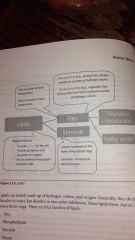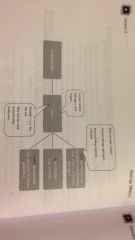![]()
![]()
![]()
Use LEFT and RIGHT arrow keys to navigate between flashcards;
Use UP and DOWN arrow keys to flip the card;
H to show hint;
A reads text to speech;
12 Cards in this Set
- Front
- Back
- 3rd side (hint)
|
What are macromolecules and what are they made up of? |
Large molecules. They are made up of smaller repeating units called monomers. |
|
|
|
What kind of chemical reaction is required to join monomers together to form macromolecules? |
It is called dehydration synthesis or condensation reaction. This means water is removed. |
|
|
|
What feature shared by all functional groups affects their solubility? |
The functional groups are all hydrophilic (attracted to water). This increases the solubility of the molecules that contain these functional groups. |
|
|
|
What are the four macromolecules of life? |
1. Carbohydrates 2. Lipids 3. Proteins 4. Nucleic Acids |
|
|
|
How are the four macromolecules of life formed? |
They are formed using dehydration synthesis reactions and are broken apart using hydrolysis reactions. |
|
|
|
How many groups are carbohydrates classified in and what are they? |
Three. 1. Monosaccharides 2. Oligosaccharides 3. Polysaccharides |
|
|
|
How many types of monosaccharide are there? And what are they? |
Two. 1. Aldoses 2. Ketoses |

|
|
|
How many types of polysaccharides are there and what are they? |
Four types. 1. Starch 2. Glycogen 3. Cellulose 4. Chitin |
|
|
|
What are the 4 main families if lipids? |
1. Fats 2. Phospholipids 3. Steroids 4. Waxes |

|
|
|
What are the 5 nitrogenous bases? |
1. Adenine (A) 2. Guanine (G) 3. Cytosine (C) 4. Thymine (T) 5. Uracil (U) |
|
|
|
What do carbohydrates contain? |

Carbon, hydrogen And oxygen. In a 1:2:1 ratio. |
|
|
|
Oligosaccharides ("olgio" - means "few") |
Contains two or three simple sugars, attached to one another by covalent bonds called, glycosidic linkages. |

|

